Senior science journalist
Archaeologists have pieced together thousands of fragments of 2,000-year-old wall plaster to reveal remarkable frescoes that decorated a luxurious Roman villa.
The shattered plaster was discovered in 2021 at a site in central London that’s being redeveloped, but it’s taken until now to reconstruct this colossal jigsaw puzzle.
The frescoes are from at least 20 walls of the building, with beautifully painted details of musical instruments, birds, flowers and fruit.
The art is revealing more about the affluence of the area where they were found – described by the team as the “Beverly Hills of Roman London”.
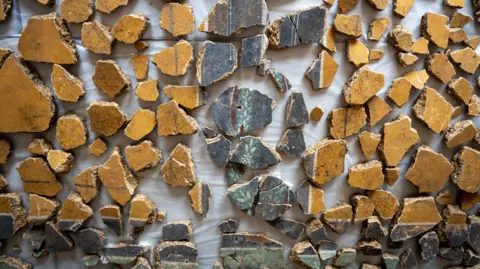 Tony Jolliffe/BBC News
Tony Jolliffe/BBC News Tony Jolliffe/BBC News
Tony Jolliffe/BBC NewsThere are also clues about who the artists were: one fragment is scored with the Latin word Fecit, which means “has made this” – but the piece where the name should be is missing.
The Museum of London Archaeology (Mola) team still hope the vital piece will be found as they sift through the fragments.
“It’s one of the biggest – if not the biggest – assemblages of Roman wall plaster and paintings we’ve ever found in Roman London,” said Han Li from Mola.
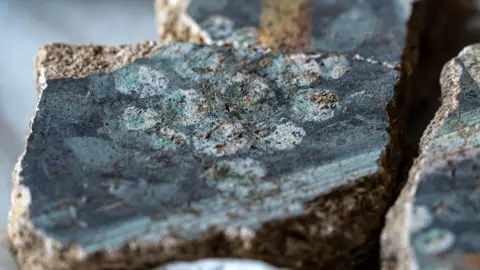 Tony Jolliffe/BBC News
Tony Jolliffe/BBC NewsThe largest of the frescoes, measuring about 5m by 3m, has a lower section of pale pink, dotted with specks of paint to imitate marble. Above are rich yellow panels with soft green borders.
The wall paintings are adorned with candelabras, stringed instruments called lyres, white cranes and a delicate daisy.
There’s also what appears to be a bunch of grapes, but archaeobotanists believe that this is a plant that grows locally – mistletoe.
“That is actually quite interesting for me, because you’re seeing that the Roman painters are taking a classical idea and they’re very much putting their own North West European, or local, twist on it. I think that’s magnificent,” says Han Li.
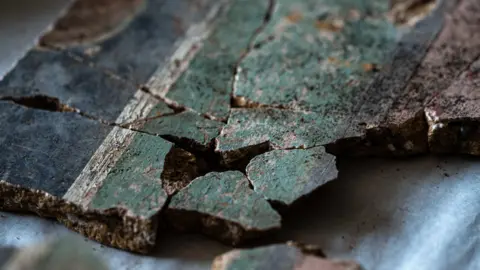 Tony Jolliffe/BBC News
Tony Jolliffe/BBC NewsHe spent many months with the jumble of plaster, meticulously examining each piece to put together what he describes as “the world’s most difficult jigsaw puzzle”.
The fragility of the ancient fragments made this even more of a challenge.
“You have to be very careful because you can only assemble the pieces a small number of times before the plaster starts to be damaged and it flakes off,” he said.
“So you have to be quite sure before you join the pieces that this is the piece that may fit.”
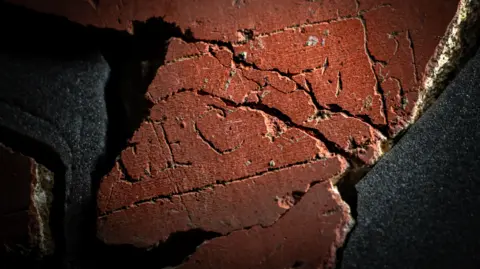 Tony Jolliffe/BBC News
Tony Jolliffe/BBC NewsThe Romans founded London in AD43, and the villa was built soon after, dating to the first or second century when the new city was growing rapidly.
The archaeologists think this grand building may have been home to a wealthy family or a hotel for rich travellers passing through Londinium.
They’ve been comparing the frescoes to others found across Britain and Europe, and they believe they were created by a group of highly skilled painters who travelled the Roman empire.
“They’ve come to Roman London where there was a building boom, with many houses and many buildings going up that required painting. And they went around essentially taking on huge commissions of work,” said Han Li.
“It’s amazing to imagine that their work is now again visible to us 2,000 years later.”
The artists’ exact identity however will remain elusive until the missing fragment bearing their names is found.
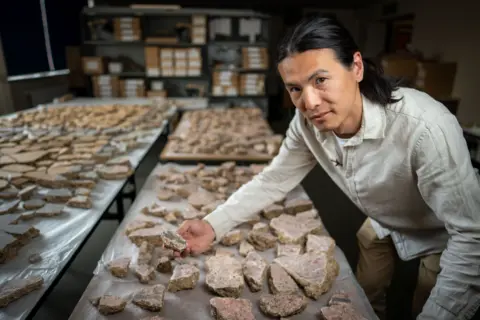 Tony Jolliffe/BBC News
Tony Jolliffe/BBC NewsThe plaster was found in Southwark, just south of the Thames. A stunning mosaic and Roman cemetery were also unearthed at the site, which was being excavated in preparation for a new development.
This location, outside of the central hub of Roman London, is also revealing more about how the city was spreading out.
“There was this thriving, bustling settlement quite early on in the Roman period, and it’s almost the kind of wealthy suburb – the Beverly Hills of Roman London,” said Andrew Henderson-Schwartz from Mola.
“And what this shows is that the Romans are committing to London. They’re investing in London, and they’re seeing it as a place to settle in, a place to stay. It’s not just a kind of provincial outpost.”
There’s still much to discover from the fresco fragments, helping archaeologists reconstruct the story of the UK’s rich Roman history.
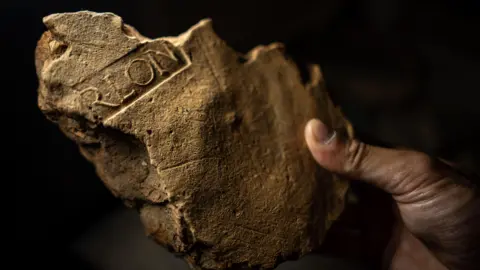 Tony Jolliffe/BBC News
Tony Jolliffe/BBC News
Get our flagship newsletter with all the headlines you need to start the day. Sign up here.



